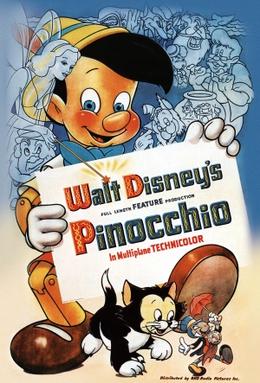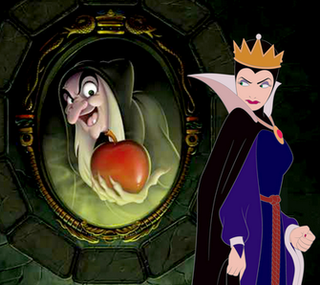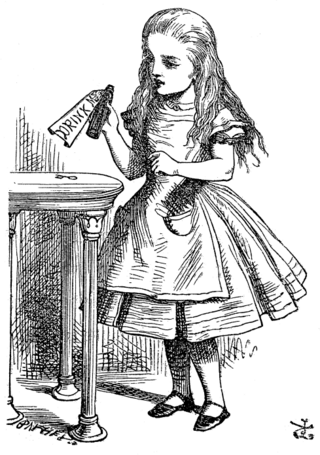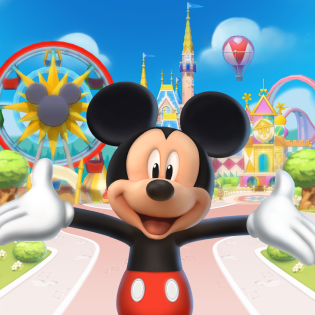
Captain James Hook is the main antagonist of J. M. Barrie's 1904 play Peter Pan; or, the Boy Who Wouldn't Grow Up and its various adaptations, in which he is Peter Pan's archenemy. The character is a pirate captain of the brig Jolly Roger. His two principal fears are the sight of his own blood and the crocodile who pursues him after having previously eaten Captain Hook's hand cut off by Pan. An iron hook that replaced his severed hand has given the pirate his name.

Dumbo is a 1941 American animated fantasy drama film produced by Walt Disney Productions and released by RKO Radio Pictures. The film is based upon the storyline written by Helen Aberson and Harold Pearl, and illustrated by Helen Durney for the prototype of a novelty toy ("Roll-a-Book").

Pinocchio is a 1940 American animated musical fantasy film produced by Walt Disney Productions and released by RKO Radio Pictures. Loosely based on Carlo Collodi's 1883 Italian children's novel The Adventures of Pinocchio, it is the studio's second animated feature film, as well as the third animated film overall produced by an American film studio, after Disney's Snow White and the Seven Dwarfs (1937) and Fleischer Studios' Gulliver's Travels (1939). With the voices of Cliff Edwards, Dickie Jones, Christian Rub, Walter Catlett, Charles Judels, Evelyn Venable, and Frankie Darro, the film follows a wooden puppet, Pinocchio, who is created by an old woodcarver, Geppetto, and brought to life by a blue fairy. Wishing to become a real boy, Pinocchio must prove himself to be "brave, truthful, and unselfish." Along his journey, Pinocchio encounters several characters representing the temptations and consequences of wrongdoing, as a cricket named Jiminy, who takes the role of Pinocchio's conscience, attempts to guide him in matters of right and wrong.

Jiminy Cricket is the Disney version of the Talking Cricket, a fictional character created by Italian writer Carlo Collodi for his 1883 children's book The Adventures of Pinocchio, which Walt Disney adapted into the animated film Pinocchio in 1940. Originally an unnamed, minor character in Collodi's novel who is killed by Pinocchio before returning as a ghost, he was transformed for the Disney adaptation into a comical and wisecracking partner who accompanies Pinocchio on his adventures, having been appointed by the Blue Fairy to serve as Pinocchio's official conscience. In the film, he sings "When You Wish Upon a Star", the Walt Disney Company's signature song, and "Give a Little Whistle".

The Queen of Hearts is a fictional character and the main antagonist in the 1865 book Alice's Adventures in Wonderland by Lewis Carroll. She is a childish, foul-tempered monarch whom Carroll himself describes as "a blind fury", and who is quick to give death sentences at even the slightest of offenses. One of her most famous lines is the oft-repeated "Off with his/her head!" / "Off with their heads!"

Fun and Fancy Free is a 1947 American animated musical fantasy anthology film produced by Walt Disney and Ben Sharpsteen and released on September 27, 1947 by RKO Radio Pictures. The film is a compilation of two stories: Bongo, narrated by Dinah Shore and loosely based on the short story "Little Bear Bongo" by Sinclair Lewis; and Mickey and the Beanstalk, narrated by Edgar Bergen and based on the "Jack and the Beanstalk" fairy tale. Though the film is primarily animated, it also uses live-action segments starring Edgar Bergen to join its two stories.

Fantasyland is one of the "themed lands" at all of the Disneyland-style parks run by The Walt Disney Company around the world. It is themed after Disney's animated fairy tale feature films. Each Fantasyland has a castle, as well as several gentle rides themed after those Disney animated feature films.

Wishes: A Magical Gathering of Disney Dreams was a fireworks show at the Magic Kingdom theme park of Walt Disney World. The show debuted at the park on October 9, 2003, and was developed by Walt Disney Creative Entertainment, under the direction of VP Parades & Spectaculars, Steve Davison, who was assigned to create a replacement for the 32-year-old Fantasy in the Sky fireworks. Several variations of the show at Walt Disney World include Happy HalloWishes during "Mickey's Not-So-Scary Halloween Party", Holiday Wishes during "Mickey's Very Merry Christmas Party", and Magic, Music and Mayhem during the 2007 event Disney's Pirate and Princess Party. The multimedia version at Disneyland Park in Disneyland Paris premiered on July 16, 2005, and had its final show on August 25, 2007. The show at the Magic Kingdom was sponsored by Pandora Jewelry. The show was presented for the last time on May 11, 2017, at the Magic Kingdom Park and was replaced by Happily Ever After in the following day.

Virtual Magic Kingdom, also known as VMK, was a massively multiplayer online game developed by Walt Disney Parks and Resorts and Sulake and published by The Walt Disney Company. It was a virtual representation of the Disneyland-style theme parks, containing areas and minigames which were based on real park scenery and attractions. The beta version opened publicly on May 23, 2005, with new lands opening up through 2007.

SpectroMagic was a nighttime parade presented in Magic Kingdom at the Walt Disney World Resort. It was introduced in 1991 as part of the park's 20th-anniversary celebrations, replacing the Main Street Electrical Parade. The parade originally ran from 1991 to 1999, then returned from 2001 to 2010.

Disney Sing-Along Songs is a series of videos on VHS, betamax, laserdisc, and DVD with musical moments from various Disney films, TV shows, and attractions. Lyrics for the songs are sometimes displayed on-screen with the Mickey Mouse icon as a "bouncing ball". Early releases open with a theme song introduction containing footage featuring Professor Owl and his class, seen originally in 1953 in two Disney shorts, Melody and Toot, Whistle, Plunk, and Boom. Professor Owl hosts some of the videos, while either Jiminy Cricket or Ludwig Von Drake host others. Later volumes, as well as the two Christmas videos, do not feature a host at all. Scenes with Jiminy Cricket and Ludwig Von Drake were taken from television programs, including the Walt Disney anthology television series and The Mickey Mouse Club, which featured the characters in the 1950s and 1960s.

Epic Mickey: Power of Illusion is a 2012 platform game developed by DreamRift and published by Disney Interactive Studios for the Nintendo 3DS. It is the third part of the Epic Mickey series, released alongside Epic Mickey 2: The Power of Two, and is touted as a tribute to Sega's Illusion series of Mickey Mouse games, particularly Castle of Illusion Starring Mickey Mouse.

The Evil Queen, also known as the Wicked Queen, Queen Grimhilde, or just the Queen, is a fictional character and the main antagonist who appears in Walt Disney Productions' first animated feature film Snow White and the Seven Dwarfs (1937) and remains a villain character in their extended Snow White franchise. She is based on the Evil Queen character from the 1812 German fairy tale "Snow White".

Alice, the main protagonist of Lewis Carroll's novels Alice's Adventures in Wonderland (1865) and Through the Looking-Glass (1871), has been adapted to several media.
Snow White is a Disney media franchise that began in 1937 with the theatrical release of Snow White and the Seven Dwarfs. It is based on the 1812 fairy tale by the Brothers Grimm.

Roger Holzberg is an American health innovator, creative director, teacher, writer, and inventor. He is the co-founder and creative director for Reimagine Well, and founded the organization My Bridge 4 Life a support network designed to help patients and families navigate the journey from diagnosis to wellbeing. He previously served as the Creative Director (consulting) for the National Cancer Institute. Holzberg was for twelve years a Vice President / Creative Director at The Walt Disney Company, both at Walt Disney Parks and Resorts Online and at Walt Disney Imagineering, until he left to found My Bridge 4 Life in 2008. He teaches the Healthcare by Design class at the California Institute of the Arts. His personal use of triathlon as a part of his own wellness plan, and as an inspiration for survivorship, was featured by ABC news in Los Angeles in a promotion for the Malibu Triathlon.
"Operation Mongoose" is a two-part story comprising the twenty-first and twenty-second episodes of the fourth season of the American fantasy drama series Once Upon a Time, both of which aired on May 10, 2015. Both episodes served together as the fourth season finale.

Once Upon a Mouse is a 1981 American theatrical featurette directed by Jerry Kramer and Gary Rocklen of Kramer/Rocklen Studios, produced in association with Walt Disney Productions. It was released on July 10, 1981 on a double bill with The Fox and the Hound.

Disney Magic Kingdoms is a 2016 city-building game developed and published by Gameloft for iOS, Android, and Windows. It is themed off the Disney Parks. The game was officially launched on March 17, 2016.
















